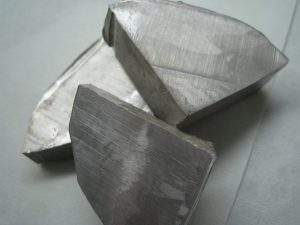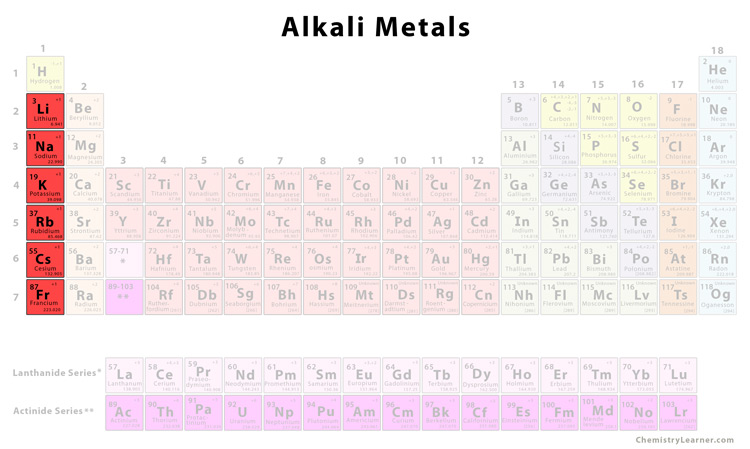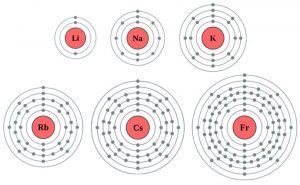Alkali Metals
- Definition: What are the Alkali Metals
- Where are the Alkali Metals Located on the Periodic Table
- List of Alkali Metals
- Common Properties and Characteristics of the Alkali Metals
- Periodic Trends of Alkaline Metals
- Video: Reactivity and Periodic Trends of the Alkali Metals
- What are the Alkali Metals Used for
- FAQ
- Interesting Facts
Definition: What are the Alkali Metals
The alkali metals, also known as the alkali metal family is a group of six elements characterized by common physical and chemical properties, a similar electron configuration, and shared periodic trends. All the alkali metals are found in nature, but being highly reactive, they do not occur freely in their pure form [1].

Alkali Metal Example Sodium
Where are the Alkali Metals Located on the Periodic Table
These are found in Group 1 (the first column from left) of the periodic table. All the alkali metals lie in the s-block since the electron on the outermost shell of their atom (valence electron) is in the s-orbital [2, 3]
List of Alkali Metals |
|
| Element Name | Symbol |
| Lithium | Li |
| Sodium | Na |
| Potassium | K |
| Rubidium | Rb |
| Cesium | Cs |
| Francium | Fr |
Why are They Called Alkali Metals
When the elements from group 1 react with water, they all form alkaline solutions. So, the family is called the alkali metal family [4].
Common Properties and Characteristics of the Alkali Metals
Physical Properties
Common Metallic Properties
- Silvery in color with a shiny appearance [2]
- Good heat and electrical conductivity
Unusual Non-metallic Properties Shared by the Group 1 Elements
- Soft enough to be cut by a plastic knife, at room temperature [5]
- Low melting and boiling points [6]
- Low density (Li, Na, and K light enough to float in water)
Chemical Properties
- All the alkali metals are highly reactive
Why are Alkali Metals So Reactive
Having a single valence electron (the electron on their atom’s outermost shell) makes all the alkali metals highly reactive at room temperature and standard pressure. It takes little energy for them to lose the electron and form positively charged ions (cations) with a +1 charge.
These elements readily react with even the oxygen in the air to form oxides that make their shiny surface turn pale gray within moments if left in open air [7].
How Do Alkali Metals React With Water
When an alkali metal, e.g. sodium (Na) comes in contact with water, the sole valence electron leaves the sodium atom and the reaction forms hydroxide and sodium ions along with hydrogen [5]:
Na2+ 2H2O ―> H2 + 2Na+ + 2OH–
The Na+ and OH– ions are quite unstable in the aqueous solution, so they form sodium hydroxide [4]. The final equation stands like the following:
Na2+ 2H2O ―> H2 + 2NaOH
Examples of some other alkali metal-water reaction:
2K + 2H2O ―> H2 + 2KOH
2Li + 2H2O ―> H2 + 2LiOH
2Rb + 2H2O ―> H2 + 2RbOH
The heat resulting from the reaction ignites the hydrogen atoms produced, causing a considerable explosion [8].
Periodic Trends of Alkaline Metals
The lower down Group 1 on the periodic table you move, the following trends are apparent in the alkali metals:
- Decreasing melting and boiling points [4]
- Increasing density and weight with Li being the lightest and Fr being the heaviest (though sodium and potassium are an exception as the latter is less dense than the former) [2]
- Increasing atomic radius
- Increasing reactivity (due to the increase in atomic radius, it is easier to knock out the valence electron in the elements located lower down the group, making Li the least reactive, and Francium the most reactive alkali metal) [2]
Video: Reactivity and Periodic Trends of the Alkali Metals
What are the Alkali Metals Used for
The top three elements of the group, Li, Na, and K, along with Cs, have different applications in various industries including glass-making, photography, weapons and explosives, and batteries Sodium compounds have some everyday uses in food processing and preparation. Rb is mainly used for research purposes [10]. Fr does not have any regular application as it is rarely present in nature [5].
FAQ
1. Why are alkali metals stored in oil?
Ans. Being highly reactive, alkali metals in their pure form have to be stored in oil to keep them from coming in contact with air and water [2].
2. What are the most abundant alkali metals?
Ans. Sodium and potassium are the most abundant alkali metals.
3. Why Is hydrogen not considered an alkali metal?
Ans. Despite having a single electron in its outermost shell, hydrogen (H) is not considered to be an alkali metal because:
- H is not a metal, it is a gas.
- It is also much less reactive, needing more energy for it to release that single electron to form positively charged ions.
- H can also gain an electron to form negatively charged ions, like the elements in the halogen group [17].
4. What is the difference between alkali metals and alkaline earth metals?
Ans. Alkaline earth metals are the Group 2 elements in the periodic table. Despite having some similarities in their physical properties, they are placed in different groups mainly because the alkaline earth metals have two electrons in the outermost shell of their atom. Since losing 2 electrons needs more energy than losing one, the alkaline earth metals are less reactive than the alkali metals [13].
5. Why are halogens and alkali metals likely to form ion?
Ans. Having 1 valence electron, the alkali metals try to get rid of it to achieve stability, while halogens (e.g. chlorine, bromine, fluorine etc) have seven valence electrons, meaning they try to gain 1 more electron to become stable. As a result, together they react to form ionic compounds like sodium chloride (NaCl) and potassium chloride (Kcl) [14].
6. How are alkali metals different from noble gases?
Ans. Alkali metals have a single electron on their outer shell, while all the noble gases (the Group 8 elements in the periodic table including helium, neon, argon) have a full valence band with no unpaired electron to cause a reaction with other molecules [15].
Interesting Facts
- The name of the alkali metal group derives from the Arabic word ‘al qali’, which means ‘from ashes’. It was named as such because most Na and K compounds were originally obtained from wood ashes [16].
- The elements in this group have the lowest first ionization energies (the minimum energy required for an atom to give up an electron) in each period [12].
References
- Alkali Metal Definition (Chemistry) ― Thoughtco.com
- The Alkali Metals ― Courses.LumenLearning.com
- Periodic Table ― ModelScience.com
- Group 1 – The Alkali Metals ―BBC.com
- Alkali Metal Elements: Properties, Characteristics & Reactions ― Study.com
- Melting points & Boiling points of alkali metals ― Embibe.com
- Group 1 properties ― BBC.co.uk
- Information on Alkali Metals ― EHS.Stanford.edu
- Everyday Uses of Alkali Metals ― SchooledbyScience.com
- Alkali metals ― ScienceClarified.com
- Alkali metals ― Open.edu
- Alkali Metals ― Tutorvista.com
- Alkali and Alkaline Earth Metals ― TechnologyUK.net
- Alkali Metals ― Hyperphysics.phy-astr.gsu.edu
- Explain how alkali metals are different from noble gases? ― Study.com
- Group Trends: The Active Metals ― Angelo.edu
- Similarities of hydrogen with alkali metals ― Embibe.com

